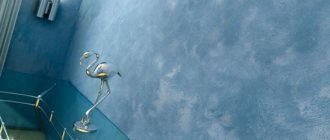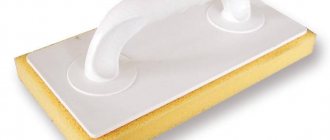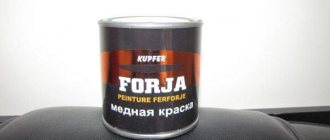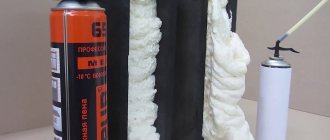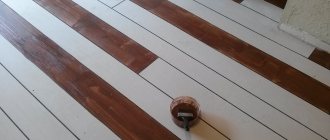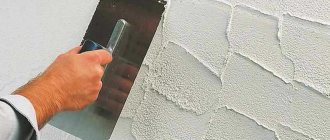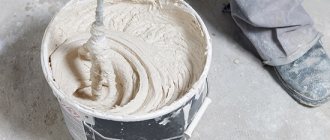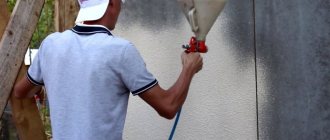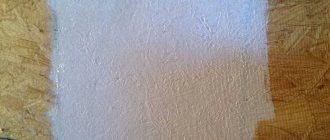Perhaps the most affordable method of facing a facade in terms of cost and ease of installation is painting it.
Modern facade paints are easy to use, give the building a magnificent appearance and fully satisfy all the requirements that apply to facing materials.
But choosing the best paint option for exterior work can be difficult, since the range of paints on the domestic market is very diverse. To find the right course in this vast ocean of all colors and shades, the developer should have a good understanding of the characteristics of paints.
Composition and features of acrylic paints
A lot of characteristics with a plus sign inherent in acrylic paints of this group arise from the composition - a dispersion (solution) of polyacrylic resins with additives.
- Acrylic copolymer monomers are the basis that determines the basic characteristics, combine and hold pigments and additives.
- Auxiliary monomers – make up up to 10% of the base and determine specific properties.
- Water, organic solvent - paints for interior work are usually water-dispersed, for facades - with water or organic solvents.
- Pigments – provide color, hiding power, and help increase resistance to ultraviolet radiation and other atmospheric influences.
- Modifying additives – regulate film formation, simplify the application process, and impart certain properties, for example, biocidal.
The paint is a viscous homogeneous mass without divisions into fractions, the consistency of which resembles liquid government sour cream. Due to the absence of typical solvents, acrylic paints, even facade paints, do not have a pronounced chemical odor. After drying, a thin, durable but permeable film is formed on the surface, freely allowing steam to pass through, but protecting the surface from all external influences.
Characteristics of acrylic paints
In fact, frozen acrylic film is the thinnest layer of plastic, hence the high technical and operational characteristics:
- Environmentally friendly - contains only safe components; Regardless of temperature conditions, the coating is not capable of releasing harmful substances into the air. There is no danger of poisoning during work, even with large volumes and without a respirator.
- Wear resistance – resistant to abrasion, ultraviolet radiation, mechanical and atmospheric influences, fluctuations in temperature and humidity conditions.
- Moisture resistance - after drying, the coating is not afraid of direct exposure to water, and the painted surface can not only be wiped, but also washed.
- Durability – the coating has excellent adhesion to almost any substrate (subject to proper preparation), and there is no possibility of peeling.
- Elasticity - the polymer base allows some movement of the base, due to which the coating maintains its integrity not only on static surfaces.
- Vapor permeability – the “breathable” film does not prevent the release of vapors, which allows the paint to be used on substrates with high vapor permeability.
- Covering power - the composition adheres well and effectively hides surface defects (up to 5 mm).
- Versatile - suitable for most indoor and outdoor substrates.
- Decorative – a wide palette and high hiding power make it possible to obtain the most presentable appearance of the painted surface. As is the case with other dyes, the desired color can not only be purchased ready-made, but also obtained by tinting on a special device or manually using specialized pigments. Acrylic paints are also available with various visual effects (mother of pearl, chameleon), which only adds to the spectacle of the coatings.
- Durability – manufacturers claim a coating lifespan of up to 15 or even 20 years. Given the properties of acrylate resin and its derivatives, it is quite possible that this is a reality. But, in the case when the technology of both preparation of the base and application is followed.
For indirect proof of good adhesion and strength, you can take one of the queries on the portal forum.
BearVG FORUMHOUSE Member
How to effectively and quickly remove a layer of acrylic paint and lime mortar from the facade to the plaster layer, if the layer consists of: acrylic paint->lime mortar->plaster layer. Interested in methods and methods for removing/cleaning from the facade. Sandblasting is not available. I tried it mechanically - it’s difficult if you use a metal brush or spatula; if you use a shovel as a scraper, it’s ineffective, just like with a hatchet.
Vapor permeability or vapor barrier - forum-okna.ru - page 2
I'll tell you the story. I hope this isn't completely off topic.
But first, a couple of questions.
Can the Customer buy windows from a window specialist, for example, without double-glazed windows?
Maybe. Why not? Whatever he wanted to pay money for, he will get it without any problems.
(see GOST 23166-99, clause 5.5.1, 5.5.2)
In this case, should the Customer report to the window designer where he will get the double-glazed windows, how he will install them, what the resulting heat transfer resistance will be, etc.?
No. Why the fright? There is no such law that a window worker can conduct “inquiries.”
Now let me ask you this: the assembly seam consists of three layers; Where is it written that the Customer must buy all three layers at once? Maybe it’s more convenient for him to do some of this work himself. He will indicate in the contract that I only want the central layer, and the window designer will have nothing to object to (IMHO!). And the window designer in this case will be responsible not for the compliance of the seam with GOST, but for the compliance of the volume of work performed with the contract.
So? Did you make a mistake anywhere?
Now the actual story.
I had a facility where the Customer crossed out the vapor barrier from the contract. Saved. He said it’s not our concern. Then he ran into IGASN and tried to make claims against us. They explained, explained, sent. And I wondered whether the “layer of plaster mortar with a high coefficient of resistance to vapor permeation”, shown in Fig., exists and is even possible. A.14 GOST 30971-2002?
I started calling plasterers. Selling nonsense “we have everything! come and we’ll sell it inexpensively,” I heard enough. But little by little, step by step, call after call, I “reached” the specialist from the technical department, Tigi Knauf. I explained the question, explained that perhaps we were talking about an unexpected new market niche - my friend became interested. I took a couple of days (!) to study the issue. And indeed, he called back later.
It turned out that the most “vapor-impervious” of the existing plasters falls short of the required parameters by an order of magnitude.
But “by an order of magnitude” gives (if I’m not mistaken, of course) exactly the numbers required for the outer, vapor-permeable layer! It turns out that ordinary plaster can be used without PSUL and without Steez.
Types of acrylic paints
Acrylic paints can be classified according to various criteria, from composition to specific properties. But given our focus, it makes sense to dwell in detail on the three main groups.
Acrylic paints for exterior use
This group is also called facade paints, since most often they are used specifically for painting the walls of houses, as well as bathhouses, utility rooms, fences, small forms, and garden decor. Facade paints are produced both with water and with an organic solvent, regardless of this, they are all designed for aggressive working environments. Modifying additives are aimed at increasing resistance to all types of influences - here are mechanical damage, precipitation, sudden temperature fluctuations, and direct sunlight. A surface painted with high-quality acrylic dye can later be washed with a hose without harm to the coating.
Acrylic paints for interior work
They are also interior paints, intended for painting surfaces that are not exposed to atmospheric influences. That is, a cold veranda can be painted, just like surfaces in the bathroom or kitchen, but if we are talking about an open gazebo, there is no need to risk it. Interior paints are predominantly water-dispersed, completely odorless, and are approved for use even in children's rooms.
Specialized acrylic paints
Manufacturers offer formulations for almost all occasions, and it is difficult to list the range item by item. A striking example of the group is acrylic paints with biocidal properties obtained by introducing a certain proportion of colloidal silver into the composition. Heat-resistant paints used for heating radiators are also in demand - budget or from the expensive segment.
Yuri Sokolov Member of FORUMHOUSE
You can paint not only with heat-resistant paint, but, for example, specifically with enamel for heating radiators. This is practically the same thing, however, heat-resistant paints are available up to 800⁰C, they are actually more expensive, and enamel for heating radiators, as a rule, is designed for temperatures up to 130⁰C and is cheaper for the same quality.
What surfaces is it suitable for?
Silicone facade paints can be applied to almost any type of substrate:
- Concrete.
- Brick.
- Plaster (sand-cement, textured, etc.).
- Old coatings (optimally silicone), subject to compatibility in chemical composition.
Water-dispersed compositions do not adhere well to old coatings that have a greasy surface or were previously coated with oil mixtures.
Such coatings must be removed before applying silicone materials; before application, a layer of deep penetration silicone primer must be applied for better adhesion.
Scope of application
Due to the high technical and operational properties, the unlimited scope of application of acrylic paints is not surprising. They can be used on almost all types of bases, be it wood, concrete, stone or metal, with the exception of some types of plasterboards, which greatly simplifies the choice of materials when carrying out finishing or repair work. In the line of any manufacturer there is always paint for interior and exterior work in a wide range of colors, therefore, there will be the same quality of the painted surface and matching shades during transitions.
When choosing, it is worth considering that there are universal paints in terms of bases, but within the group they usually differ in the specific application - for walls, ceilings and floors. This is due to a practical component - these zones have different operating conditions, and they look different due to the different angle of incidence of light. And the application technique is different, which determines the consistency and composition of the additives.
The popularity of acrylic paints is also explained by the atypical color range - while standard floor enamels are overwhelmingly brown, acrylic ones can be of any color.
Vlademir FORUMHOUSE Member
My wife wants floors at home that are not the color of traditional floor paint, but light, with a brownish tint, that is, as light as possible. Nearby stores offer acrylic flooring; the manufacturer's assortment includes a light color. Does anyone have experience?
Eat.
Nika19 Member of FORUMHOUSE
We painted with water-soluble acrylic, the color was a straw. It turned out to be light-light yellow, a nice shade, I also love light floors.
Is it possible to paint aerated concrete blocks without plaster?
Aerated block is a building material that requires mandatory finishing. This is due to the high hygroscopicity of cellular concrete. Therefore, finishing for aerated block walls must meet three basic requirements:
- prevent street moisture from penetrating into the concrete structure;
- provide the necessary vapor permeability so that the walls “breathe”;
- ensure normal operation of the building.
Facade plaster fully meets these requirements. Aerated concrete paint for exterior use is applied on top of the plaster layer, which gives the wall the desired color and texture. Is it possible to paint aerated concrete without plaster? It is possible if the selected paint for aerated concrete meets the specified requirements, that is, it forms a vapor-permeable, moisture-resistant layer on the surface. Not all paints and varnishes have such properties. So how to paint aerated concrete blocks on the outside without plaster, and what paint should you use to plaster the walls? Let's look at different types of paints in more detail.
Technology and application nuances
No special skills are required when working with acrylic paints; on the contrary, they are characterized by ease of application and lack of drips. However, the lion's share of success lies in careful preparation of the surface to be painted and compliance with the manufacturer's recommendations.
Preparing the base
The specific algorithm of work is determined by the type of base - if wood often requires sanding, then it is enough to clean concrete/brick/stone from dirt and dust. But in any case, the base must be clean, durable and necessarily primed, preferably with a primer from the same manufacturer as the paint. At a minimum, the primer should be compatible with the acrylic paint. Again, primer for wood should have an antiseptic additive, and for metal – with anti-corrosion properties.
Inngrid Member of FORUMHOUSE
I'm about to paint a cast iron battery, I'm choosing from acrylic heat-resistant paints/enamels. They write everywhere that before painting with them it is better to prime the surface with anti-rust primer or a primer directly over the rust (there is rust on the surface of the battery in some places). What primers are suitable for acrylic enamel for radiators?
Yuri Sokolov
There are special primers for rust. There is a 3-in-1 enamel primer, but this is not for batteries; here it’s better to use a primer first. Cover the pre-prepared heating radiator with it. If you paint with acrylic paint, you can use almost any acrylic primer; if the volume is small, take the primer in an aerosol can.
The main thing is that there must be soil. Otherwise, not only will the consumption of not the most budget paint increase, but the quality of the final layer will also deteriorate. It is also important to observe the time interval between layers. How long the primer needs to dry depends on the specific brand, but modern products usually do not require too much downtime and dry in a few hours. If we are talking about loose surfaces with high absorbency, the primer is applied twice - the second layer after the first has dried.
Considering that the composition dries quickly enough so that you don’t have to spend time and tediously washing surfaces that are not intended for painting, you should use masking tape before applying paint. It will also help you get clear, even lines without bleeds if there is a gradation in color or imitation of panels.
How to paint aerated concrete blocks?
To choose the right paint for aerated concrete, we offer a simple algorithm:
- Will aerated concrete be coated with plaster before painting?
- Vinyl
- Silicate
- Water-epoxy
- Polymer
- Water soluble
- Acrylic
- Oily
- Silicate
- Water-epoxy
- Oily
- Water soluble
- Acrylic
- Vinyl
- Polymer
When choosing what to paint aerated concrete on the outside, you also need to take into account the air temperature (not all paints and varnishes can be used at temperatures below +10°C), consumption and cost of painting 1 m², and drying time.
